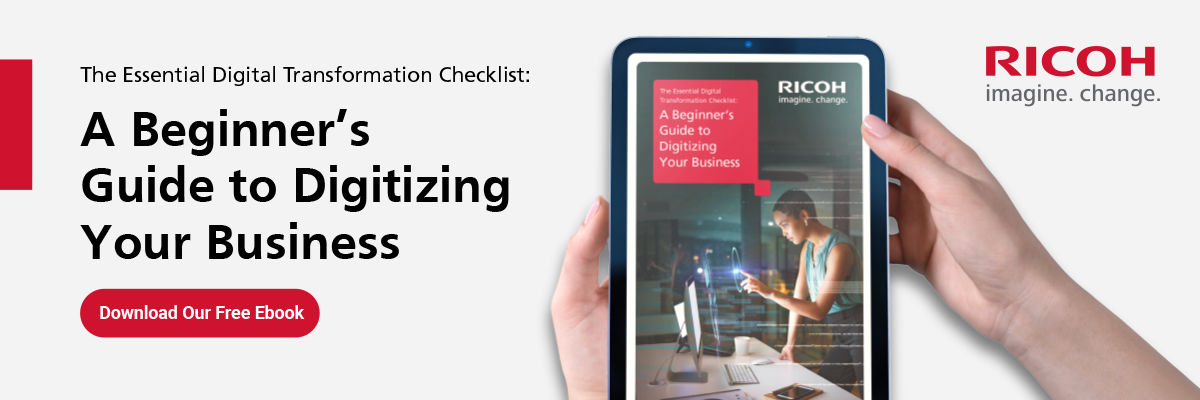Bringing your library of paper files into the digital world is a crucial step toward greater ease and efficiency at work.
In the modern business world, a document is just as likely to be a computer file as a piece of paper. Finding the answer to “what is document digitization” means unlocking more security and efficiency for your company’s daily operations, but the idea of trying to adopt new technologies can feel overwhelming, especially for enterprises that have historically relied on physical records.
Fortunately, with the right tools, even the most entrenched analog companies can transform their file folders into an organized digital system. Here are the essentials of digitization and how this approach to documents can benefit your business.
Read The Complete Guide to Document Digitization discover the benefits of digitization, get process recommendations, and much more.
What is document digitization?
Document digitization is the creation of a digital version of an analog item, such as a contract, form, map, or book. Digitization involves scanning a physical document to convert its text and imagery to digital information. Document scanners use a powerful combination of hardware and software to convert physical documents to digital images. The software included with these devices can further enhance these images by changing the format and color depth or extract text and metadata for workflows. That's the basic technology behind digitization, but advanced scanners can offer a range of additional capabilities besides recreating a digital copy.
Some scanners specialize in high volumes and can keep up with a large quantity of documents. Others can remove imperfections in the scan with automated image correction tools. Scanners might also sync with software services for organization, such as an automatic system for naming and storing the newly created digital files. Another scanning technology that's particularly relevant for business interests is optical character recognition. Rather than simply recording an image of text, OCR creates a file where that text can be edited or searched after scanning.
How does document digitization fit into modern business models?
Paperwork is just one facet of how businesses can go digital. Many modern internal systems begin with digital data. For instance, if you have a digital platform for critical functions such as payroll, it makes multiple departments' jobs easier and more consistent to also have digital logs of pay stubs, tax forms, and other related paperwork. With a digital system, information can be easily accessed by exactly the people who need it.
Digital documents also mean a trustworthy backup system. With digitization, there's almost no chance that a one-of-a-kind document gets mistakenly tossed in the trash and lost forever (there are no accidental tears or coffee spills in the cloud). Protecting your digitized data with modern security protocols also provides more cost-effective protection than secured storage rooms.
Many companies searching for “what is document digitization” are also scaling up remote or hybrid work. Being able to access important files from anywhere is a key factor to engaging in business as usual no matter where employees clock in. Document digitization can allow both individuals and your whole organization to be more flexible in the face of any new challenges to your work environment.
Did You Know?:ScanCare combines preventative maintenance, scanner consumables, and training with on-site service to offer one of the most comprehensive service programs in the industry.
What do you need to start the digital transformation process?
The key to a successful digital transformation is having a good plan. Think critically about your business' needs. Where are your biggest document bottlenecks? How many documents will you be digitizing every day? Who will be responsible for overseeing the document digitization effort? When will the scanning happen in your standard workflow? Which departments need to agree to the transition? Additionally, if you are already underway with a digital transformation at your company, how will your document digitization efforts synergize with the other systems you've adopted?
In creating your transformation plan, be sure to account for education and training. Clearly communicate expectations about the digitization tools, and have a point person to field questions during the transition. Big organizational shifts will be most effective when you have buy-in from across your business.
Once you've laid the groundwork by answering those questions, then you're ready for the digital transition to begin in earnest.
Did You Know?:Find out more about how the digitization of records helps organizations stay efficient.
Our recommendation: fi Series scanners
Start with a scanner that can help you systematically digitize your existing library of documents as well as future paperwork. The fi Series scanners can handle nearly all specifications for operations of any size.
Large-scale operations that will manage a heavy volume of documents could benefit from a tool like the fi-8170, which can scan up to 70 pages a minute and boasts an image resolution of 600 DPI. The networked fi-7300NX is a good match for businesses that are already integrated with cloud-based technologies. Whatever your company needs, our collection of scanners has an ideal match for your document digitization efforts. Click here to learn more or shop the rest of our production scanner line.









